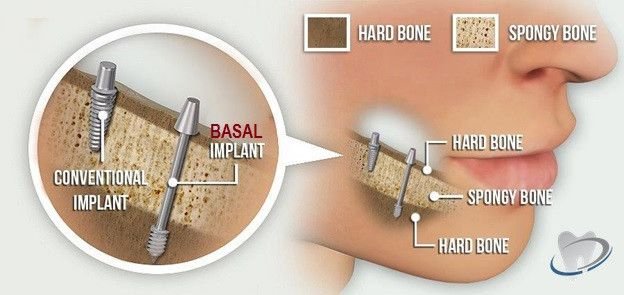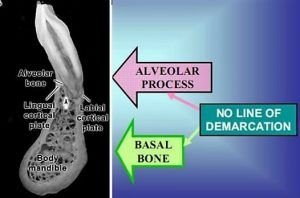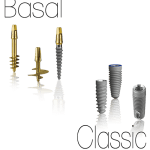Why you should avoid basal implants?

While searching for dental implants you might have come across with the terms crestal or endosseos implants (conventional) and basal or discoid implants.
The two types differ in
- Insertion in the Bone : Crestal is inserted at 90 degrees to the jaw bone, no cutting of gum is required minimally invasive. Basal is inserted side wise or parallel to jaw bone, the process is invasive, but once the basal disc implant is lodged it is sturdier.
- Integration with Bone : Crestal implants need bone to grow around the inserted implant to give it sturdiness and stability before it can take load, basal implants can take load of a new abutment and crown immediately, because they INSERTED in bone and there is NO integration.
- Total Time taken to complete the implant process : Crestal implant requires more time as the inserted implant needs to be lodged in bone with additional bone formation around it. Basal implants after inserting in the bone can also be loaded with abutment and crown immediately, practiced by many dentists as ‘teeth in a day’
- Healing after surgery : Basal implants surgery is invasive hence takes more time to heal, Conventional implants surgery can heal within a week.
- US FDA Approval : Basal Implants are not US FDA where as crestal or conventional implants are United States Food & Drug Administration approved
- Cost : Basal implants are cheaper than conventional implants, cost of production and no regulatory compliance keeps their cost low.

Understand Crestal Implants 
Understand Basal Implants

What is Basal?
Basal is a type of bone in the jaw in which implant is placed curious minds can see the picture below for more details.

Our view & opinion on “Avoid Basal Implants”
Basal Implantology is a relatively new type treatment with new broad indications and almost no limitations.
These hard bone supported implants are placed for immediate loading.
Even then at Center for Dental Implants & Esthetics we maintain that basal implants should be used as a last resort when no other implant treatment option or ridge augmentation or grafting is possible in simple terms when conventional implants are not possible.
Why do we say avoid basal implants?
- Insertion of basal discoid implants is more invasive (deeper surgery) in comparison to the insertion of Crestal implant which is traditional or classical dental implant.
- As the basal disc like implants are inserted from the from side rather than at 90 degrees to bone as in case of classical Crestal (conventional) implant, gums are required to be opened up from the bone surface extensively.
- This can cause delayed healing especially in aged patients, the blood supply from beneath the gum to the bone reduces It is thus not advisable to open the gum extensively just for placement basal implants.
- We believe patients should have minimum discomfort with least invasive process.
Research & History Suggests Avoid Basal Implants
Scientific Literature published in medical journal PubMed about basal-discoid implants is minimal. Also information on follow up of these types of implant is available for a shorter duration.
This technique is new and needs longer years of follow up to actually perceive its success or failure.
Carl. E Misch who is considered Godfather of modern Implantology could publish a 5 year long follow up study on 36 patients only that also with a slight modification in the technique. Other case reports which are published are of little clinical significance since they referred to few number of case and are not considered rich and authentic.
Our views are seconded by a report published in 2015 confirmed our view point where a patient reported, fractured basal- implant and its removal became the concern for the dentists as a lot amount of bone was lost in retrieving the broken implant.
In the light of the available facts and study reports, we conclude that, Basal implants, although, have some advantages (immediate loading & possibility of dental implant in low bone density, low availability of bone) there are more known disadvantages like difficult retrieval after a fracture, more swelling and patient discomfort.
Which is why indiscriminate use of basal-discoid implants when other treatments are possible should be avoided and basal implants should be done only when absolutely necessary.


Additional Reading
Basal Implants vs Conventional Implants
Dental Implants in Just 4 Weeks
Regain Your Perfect Smile With US FDA Approved Zero Risk Conventional Implants

Dr. Jyoti Singh (MDS), Diplomate WCOI (Japan region) Member AAID (American Association of Implant Dentistry) stands as a beacon of excellence in implantology within Delhi NCR region. She is a BDS and MDS(Prostho) both from Maulana Azad Institute of Dental Sciences, where she secured top honors with all India rank 1 in PG entrance examination. Her extensive experience at esteemed institutions like Clove Dental and her own Center for Dental Implants & Esthetics since 2016, Dr. Singh embodies unparalleled expertise in dental implants. Boasting a wealth of 17+ years in dentistry and backed by 18 groundbreaking research papers in leading international journals (Google Scholar) and her ResearchGate profile, she epitomizes the pinnacle of proficiency and innovation in her field. She practices in Gurugram as your friendly dentist near me.




What’s your view about screw-based basal implants? Are they bad as well? Thank you!
Well we do not say that Basal Implants are bad. Choice of basal ideally should be based on amount of bone, if the bone is not sufficient for conventional endosseous implant, then basal can be chosen. We have seen these days that, conventional all on 4 implants are possible yet Basal are done in the name of immediate loading. Basal implants in cortical bone when fail create lot of challenges for the patient and more often than not patient is old and to retrieve a failed basal implant is surgical procedure which can be avoided if judicious choice is made.
Basal and cortico-basal implants are the devices of first choice, because they allow immediate functional loading in almost any clinical situation and they help avoiding risky bone buildup. And they do not lead to the dangerous disease named “peri-implantitis”. Patients which are treated with conventional implants see peri-implantitis in more than 50% of the cases. Every 2nd implant is prone to failure and if it happens, the patients are suffering from these implants all their life until the are finally removed.
Today there is almost no indication any more for conventional dental implants. In Germany the conventional implants are considered not to be “state of the art” any more, and this is communicated openly and discussed in the journals. The time for conventional dental implantology is over.